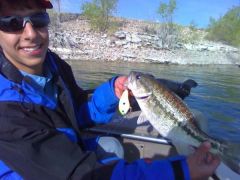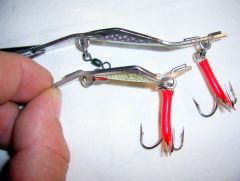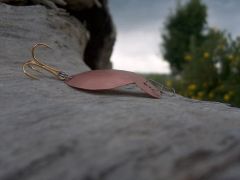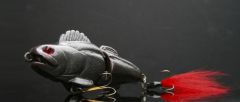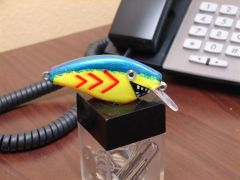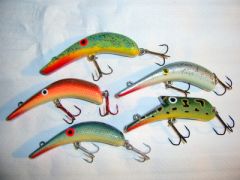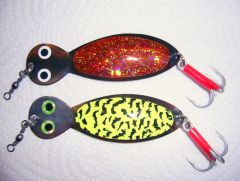-
Posts
3,867 -
Joined
-
Last visited
-
Days Won
23
Content Type
Profiles
Articles
TU Classifieds
Glossary
Website Links
Forums
Gallery
Store
Everything posted by diemai
-
-
-
Only know them bass from pictures , ......but though being not quite small , this one is rather slender in body shape . We have the same with our local perch over here as well , ....some waters hold real fat high bodied ones , whereas in other swims the fish also have a rather slender shape , .....and this even if they would be in comparable lengths of body . Still a nice fish , though , .......congrats , Jacob ! greetz , Dieter
-
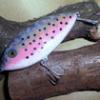
Why are my posts being deleted?
diemai replied to WishinIwerFishin's topic in TU Site Info & Updates
@ WishinIwerFishin You may still post pictures in the forums , BUT none of your finished lures just to show them ! Pictures in the forums section are allowed , if they do show and/or explain certain features , constructions , paint methods , working processes , etc . , etc. , on lures , jigs , tools and so on .....! For simply displaying and showing your finished work please utilize the gallery ! greetz , diemai:yay: -
Thanks a lot for your kind words:yes: , guys ,........much appreciated:worship: ! At my boring nightshifts I always used to think about fishing and lures , so sometimes things like these come out of it (presently I'm thinking 'bout the same at my boring lateshifts:lol:) ! @ rofish The payment is sore fingertips and arms , blisters on the hands and on rare ocassion split fingernails , ..............and one or another fish caught , naturally:lol: ! Thanks a lot again for your warm comments again , ....greetz:yay: , Dieter
-
@ spoopa Probably try to obtain some brass sheet in an RC model shop . These alloys are still easy to work with(still just a little harder and more rigid than copper) . Or try your luck at scrabyards ,..... but since there are different alloys for different purposes around better take a file(or also shears) along to make a few strokes or cuts on the material , this will give you an idea about its hardness , ......if it removes or cuts material easily , its OK ,..... but if the file just slides over just scratching the surface , drop it ,....... that sheet material won't cut and bend easily ! good luck , Dieter
-
-

Lure testing....you never know what will happen
diemai replied to mark poulson's topic in Hard Baits
@ mark poulson Nice read , I've enjoyed it:yes: ! Never underestimate small or unknown waters , ...........most other guys do , so the fish in there can grow big:yes: ! Also have a pond round the corner , where I've tested my lures for many years now , but a sign post put up a few years ago there indicates "NO FISHING" now , .........I've always ignored it , since I wasn't sure , whether there would be any pike and perch in it but only non-predatory fish . Before the sign was there , I sometimes used to catch bait minnows there with a long pole rod ! And indeed I've never hooked a predator accidentally , but I also always make a helluva noise on the water to chase them off the spot and also don't cast too far with my test lures . Anyway , recently there was an announcement in the local community newspaper , that the guy , who stocks and owns the fish in these small town ponds(there are a few more around) , got to know about unknown persons poaching the fish stock and asked potential whitnesses to inform him or the local police station ,..... also offered reward , if my memory serves me right . So well , I don't have any other easy way to test my latest lures January through April , so I guess , in future I would better now substitute the hooks on the lures for paperclips or similar for their test runs , ..........I can just imagine the dump faces of the cops , that might show up to investigate about poaching , ...............no hooks , no(illegal) fishing , no charge;) ! greetz:yay: , Dieter -
-
In the comment section of TU member spoopa's latest gallery upload "Inspiration from Creature Spoon" a discussion about connector snaps and/or wire form "omega clips" rigged onto spoons has come up , so I' d just like to display these some of my earlier spoon models , on which I had first utilized both methods . My goal of design back in those days(maybe 10 years ago ???) was to achieve a spoon model without requiring any cupping with a ball peen hammer , but simply to be bend over the edges of a vise( I finally achieved sucha successful spoon model by now with my "DinnerBell" spoon) . The first models I had furnished with a row of attachement holes , since I had no idea about where the locations of line tie and hook had to be to provide the best possible action(if there would be any action at all ???) . When first casting these spoons with snaps attached , I had found the snaps to ocassionally accidentally open , if rigged the wrong way(put them all in proper direction by now) . After I had found about those eye locations , I had furnished a second batch with these "omega clip" wire forms , that I have described in spoopa's upload comments section . I had named these spoons "Rhombo"(the elongated one) and "PikeKite". Haven't fished them much , since they turned out to have some drawbacks : "Rhombo" rises up very quick , one has to take care about retrieve pace not to have it break through the surface to loose its pronounced side-to-side roll and wave pattern . "PikeKite" probably has the most un-aerodynamic shape and thus casts into unpredictable directions ocassionally , also the hook sometimes tangles into the main line , since the distance between line tie and rear hook eye came out to be too short ! !t also rises up quick(obviously all spoons with their line tie behind their front tip do that more or less) , but not as much as "Rhombo" ,.... and really acts like a simple old fashioned children's kite , .........it comes back tail down wiggling side-to-side a bit , on speed increases or little twitches it does randomly change direction just like a kite in the wind , when one tightens the attachment line(it also breaks out to the sides) . Anyway , as said before , haven't fished these much , only for one or two seasons back then they were in my boxes , haven't caugt on them either , .....only had a big zander(walleye) follow up a "PikeKite"once , but it turned away , as it saw me standing on that pontoon . Well , now that I gained more experience in fishing , I am thinking to give them another try , ........otherwise they surely served as another step in my learning curve ! Anyway , the viewers should not consider these as perfect lures , just for examples for the previously mentioned line tie methods:yes: . greetz , diemai
-
In the comment section of TU member spoopa's latest gallery upload "Inspiration from Creature Spoon" a discussion about connector snaps and/or wire form "omega clips" rigged onto spoons has come up , so I' d just like to display these some of my earlier spoon models , on which I had first utilized both methods . My goal of design back in those days(maybe 10 years ago ???) was to achieve a spoon model without requiring any cupping with a ball peen hammer , but simply to be bend over the edges of a vise( I finally achieved sucha successful spoon model by now with my "DinnerBell" spoon) . The first models I had furnished with a row of attachement holes , since I had no idea about where the locations of line tie and hook had to be to provide the best possible action(if there would be any action at all ???) . When first casting these spoons with snaps attached , I had found the snaps to ocassionally accidentally open , if rigged the wrong way(put them all in proper direction by now) . After I had found about those eye locations , I had furnished a second batch with these "omega clip" wire forms , that I have described in spoopa's upload comments section . I had named these spoons "Rhombo"(the elongated one) and "PikeKite". Haven't fished them much , since they turned out to have some drawbacks : "Rhombo" rises up very quick , one has to take care about retrieve pace not to have it break through the surface to loose its pronounced side-to-side roll and wave pattern . "PikeKite" probably has the most un-aerodynamic shape and thus casts into unpredictable directions ocassionally , also the hook sometimes tangles into the main line , since the distance between line tie and rear hook eye came out to be too short ! !t also rises up quick(obviously all spoons with their line tie behind their front tip do that more or less) , but not as much as "Rhombo" ,.... and really acts like a simple old fashioned children's kite , .........it comes back tail down wiggling side-to-side a bit , on speed increases or little twitches it does randomly change direction just like a kite in the wind , when one tightens the attachment line(it also breaks out to the sides) . Anyway , as said before , haven't fished these much , only for one or two seasons back then they were in my boxes , haven't caugt on them either , .....only had a big zander(walleye) follow up a "PikeKite"once , but it turned away , as it saw me standing on that pontoon . Well , now that I gained more experience in fishing , I am thinking to give them another try , ........otherwise they surely served as another step in my learning curve ! Anyway , the viewers should not consider these as perfect lures , just for examples for the previously mentioned line tie methods:yes: . greetz , diemai
-
In the comment section of TU member spoopa's latest gallery upload "Inspiration from Creature Spoon" a discussion about connector snaps and/or wire form "omega clips" rigged onto spoons has come up , so I' d just like to display these some of my earlier spoon models , on which I had first utilized both methods . My goal of design back in those days(maybe 10 years ago ???) was to achieve a spoon model without requiring any cupping with a ball peen hammer , but simply to be bend over the edges of a vise( I finally achieved sucha successful spoon model by now with my "DinnerBell" spoon) . The first models I had furnished with a row of attachement holes , since I had no idea about where the locations of line tie and hook had to be to provide the best possible action(if there would be any action at all ???) . When first casting these spoons with snaps attached , I had found the snaps to ocassionally accidentally open , if rigged the wrong way(put them all in proper direction by now) . After I had found about those eye locations , I had furnished a second batch with these "omega clip" wire forms , that I have described in spoopa's upload comments section . I had named these spoons "Rhombo"(the elongated one) and "PikeKite". Haven't fished them much , since they turned out to have some drawbacks : "Rhombo" rises up very quick , one has to take care about retrieve pace not to have it break through the surface to loose its pronounced side-to-side roll and wave pattern . "PikeKite" probably has the most un-aerodynamic shape and thus casts into unpredictable directions ocassionally , also the hook sometimes tangles into the main line , since the distance between line tie and rear hook eye came out to be too short ! !t also rises up quick(obviously all spoons with their line tie behind their front tip do that more or less) , but not as much as "Rhombo" ,.... and really acts like a simple old fashioned children's kite , .........it comes back tail down wiggling side-to-side a bit , on speed increases or little twitches it does randomly change direction just like a kite in the wind , when one tightens the attachment line(it also breaks out to the sides) . Anyway , as said before , haven't fished these much , only for one or two seasons back then they were in my boxes , haven't caugt on them either , .....only had a big zander(walleye) follow up a "PikeKite"once , but it turned away , as it saw me standing on that pontoon . Well , now that I gained more experience in fishing , I am thinking to give them another try , ........otherwise they surely served as another step in my learning curve ! Anyway , the viewers should not consider these as perfect lures , just for examples for the previously mentioned line tie methods:yes: . greetz , diemai
-
@ spoopa I make these "omega clips" out of 1,5 mm SSt welding wire(would't trust thinner one either) ,..... I don't have any worries about it ! My PB pike of approx. 47" hung onto such a clip mounted on a 1,5 mm thick aluminium sheet crankbait lip("Cisco Kid" style) , to my surprise not even the kinked lip had de-formed ! A friend of a friend even boated an European silure of approx. 66" on one of my crankbaits made that way , .......no problems about those clips ! Made of wire of the mentioned thickness these wire forms are at least more though as thinner gauge copper sheet , I suppose ? greetz , Dieter
-
@ JBlaze Though I might never use such corkscrews for my own fishing over here , I still find your technical solution about that little tool to be very smart and handy:yes: ! Well thought off , John , indeed ! Greetz , Dieter:yay:
-
-
-
@ hazmail , @ Balls Thanks for your "joint venture" posting these pics , .......very informative:yes: ! Love these lures and their paint jobs, indeed:yes: ! greetz:yay: , diemai
-
Sadly it's not quite visible , how you did the line tie construction , seems to me , that it is a twisted wire eye passing through the lip and leads to the inside of the body ? By the lip/line tie configuration I assume , that it probably would have a very strong roll from side to side(at least , if the lip is rather narrow) , but maybe , the second section also minors this compared to a one piece lure with sucha lip ? I find round bodied crankbaits to be a little" problematic" in terms of too much rolling , personally I don't like such an action a lot , also they are limited in terms of certain action patterns. One can get some different action patterns out of such spindle shaped lures by carving plain or curved surfaces on head and/or flanks , also mount "kinked" metal lips(like "Creek Chub Pikie" style) or utilize bended metal lips , screwed under the chin(like "Cisco Kid" style) . But it's your own distinctive personal style to make your baits like this , probably these work best for your own fishing , and surely I don't intend to tell you , how to do your lures:nuhuh: . Just my ! greetz:yay: , diemai
-
-
@ onelastcast Thanks a lot , ........don't know , if you've already seen it , but there is an old thread dating back a couple of months titled "new Banana lure" , ........there are a few pictures there showing working processes and initial sketches dealing on this type of lures . Probably might be useful to you , if intending to make your own ? Just type the title into the "search" bar top right and you'll get there . greetz , diemai
-
@ mark poulson Hahaha , Mark , .......didn't even know , what a "chatterbait" is , I did google for it to get an idea and viewed some pictures . These are unknown over here ,........still ????? Anyway , as you've said , they do have one pivot point more to prevent leverage , also some have the snap rigged with the closure snap standing away from the blade , so such accidental opening can't happen , anyway . I had just noticed these snaps to accidentally open a few times , when fishing some weird spoons , that I had designed many years ago , ..........if my memory serves me right , even only the acceleration force on a powerful cast could already cause the problem , .........so later I had put them all the other way round . greetz , Dieter
-
Pretty nice idea about the downrigger trolling ,..... haven't thought about that , it's not very common around here(only on a few bigger lakes and the Baltic Sea) , most likely even tossing crankbaits behind a boat is not allowed everywhere . But it is really a good method to keep your spoons off the bottom As far as for the line tie , ........you can take a piece some thicker , rigid SSt wire , maybe 2" to 3" , and grind a point to either end(eases rigging) . Bend it around a vertically clamped nail to an "U" shape , leaving one shank little longer than the other . You need to drill two holes in line through your spoon , best of same dia. as the wire , their distance to one another accordingly to the shanks' distance of your wire form(desired eye size) . Lead the wire form through the holes ,..... as said before , a snug fit is of advantage ,.....clamb the "U" bend in a vise letting it protrude a bit to make up for a line tie and bend the two shanks offset down the spoon's plane . Snip off shanks to a remaining length of 1/4" or little less and gently hit them with a hammer to achieve a sharper 90
-
A very interesting variation , Jacob , I like it ,..... you also wrote a very informative describtion to it ! But I guess , that for my own demands it would rise up too fast due to the line tie location:? . But I am looking forward to your first outdoors report;) . I have made spoons before with such a duolock snap line tie , it is quite a PITA to rig the snap into the two holes , .......what I have found out is , that the snap could accidentally open , if rigged the way that you did . It is better to put the snap the other way round , so that the closure hooklet would stand away from the spoon , otherwise under tension of a big fish or a snag leverage of the spoons surface or the rim of its hole against the closure hooklet or its shank may open up the snap . You were right to say in your comment to my version , that bath tub testing often won't show the full potential of a lure , ...I have fished my spoons for a while yesterday in a canal in Hamburg(check picture at http://www.flickr.com/photos/lange17/1140071514/in/pool-hoheluft) , and I must say, that they do wiggle more , as I have thought at first ,..... just as you have written in your statement about the pivot point ! Also it does overturn on a sharp twitch(but doesn't constantly spin) , but this only adds more flash to it . Probably your wider version won't , since it has more sideward stability due to being not as narrow:? . And these spoons do cast pretty well ,.... I had to take care not to hang them into the trees on the other side of the canal ,..... most likely the pike hang out below the branches or that theatre barge there , caught a few smaller ones there before ,..... but this time they were unwilling to strike . greetz , Dieter:yay:
-
On lipped lures it would surely be better to position the tow eye vertical , not horizontal , like you did on this one . This is essential , if your crankbait should come to track not straight or even tend to lay on its side on retrieve , a vertical line tie you can slightly bend to the opposite direction , if the lure won't come back straight to you . Even only a little improper positioning , angling or a slightly unsymetrical shape of the diving lip will cause the bait not to track straight , so tuning of the tow eye is required quite often . Such horizontal tow eyes are sometimes utilized on(lipless) sinking glider jerkbaits to improve their sideward darting/gliding action . greetz , diemai:yay:
-
Thanks for your kind words and input , guys:yes: ! @ spoopa , @ JBlaze I fact that plane head portion leaves some chances for experiments by altering its angle or line tie location . Right now it is set in a way , that if laid on a plane surface it would sit flush with the tip of the tail on that surface. When trying out the initial blank in my bath tub I had bent the head plane a bit to change its angle , and even a little change of angle altered the swimming behaviour visibly . If the head plane would sit more into the direction on the cupping curve , the spoon would tend to wiggle more to a certain grade before overturning , .......if bent vice versa , creating an increasing kink between rear cupping and head plane , it rises to the surface much faster , the wiggle on slow retrieve decreases and probably the darting action on a jerk might increase . Same think would probably happen , if the line tie was located about between the eyes:? . You cannot utilize the principle of a crankbaits lip for spoons , it would not work the same way ,........simply because the spoon lacks one important feature ,.... which is buoancy . You cannot make a spoon to run deeper with any kind of a lip , only simply the shape and weight of certain models make'em go deeper than others . What you can do with a kinda a lip and/or head plane , is to let them rise up fast off the bottom or let them swim just below the surface(even if of higher weight) . A line tie located a bit to the rear of the forward tip on any spoon(behind the "usual place") , lets the spoon rise up faster as well , thus it creates a kind of upward "diving bill"(or better said "rising bill")in front of it . Such spoons might require a pronounced cupping and body curve to still achieve a sufficient wiggle , because such line tie configuration causes the lure to swim more or less tail down , the water pressure in this swimming position counterworks an easy wiggle generated by the curvature and cupping this way as if it would , if the spoon swam in an about parallel level to retrieve direction(line tie at nose tip) . There are very few spoons of yesteryear around , employing such principle ,..... the only ones that I know , are the "Cohokie Spoon"(made some knock-offs years ago) and the famous "Helin's Swimmer Spoon" , the latter even has an interchangeable buoyant top part , you might say , that it is a blend of a spoon and a crankbait . Also made two other weird spoon designs of my own having their line tie behind their nose tips , but I'm not too satisfied with these , .......one rises too fast and the other one casts in to unpredictable directions , .....thus haven't fished them much , though I once had a big zander(walleye) follow the latter one:huh: ! @ mark poulson Mark , in fact I've never thought about , which kinda designs I'd paint on , only that I intend for one in "glow-in-the-dark" as well , but thanks for the advice , anyway ! Thanks again , . ....greetz , Dieter





